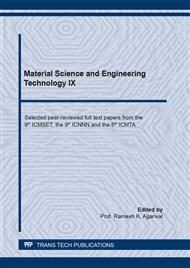p.3
p.9
p.15
p.21
p.29
p.37
p.45
p.53
Evidence of Hole Self-Doping due to Excess Oxygen Addition in Polycrystal LaMnO3
Abstract:
We have presented the evidence of hole self-doping due to excess oxygen addition in polycrystal LaMnO3 (LMO). The polycrystal LMO samples were prepared by use of a solid-state reaction method. Powder mixtures with a molar ratio of 1:1 between La2O3 and Mn2O3 were pre-annealed at 1100oC for 18 hours in the atmospheres of oxygen gas, helium gas and vacuum. By this heat treatment, non-crystalline LMO samples were produced. After that, the non-crystalline LMO samples were grinded and were pressed into pellets at the pressure of 3t/cm3. The pellets were annealed at 1100oC and 1300oC for 18 hours in the same atmospheres as the pre-annealing. Through these processes, polycrystal LMO samples were finally produced. To investigate crystallographic structure of the LMO samples, X-ray diffraction (XRD) measurements were performed by use of Cu-K radiation. From the experimental results of XRD measurements, we have found that all LMO samples have perovskite structure and are polycrystals. In addition, to investigate surface structure of the LMO samples, scanning electron microscope (SEM) measurements were carried out. Electrical resistivities (ERs) of the polycrystal LMO samples were measured as a function of temperature (4K-300K). The ERs of polycrystal LMO samples produced in an oxygen gas atmosphere show lower values as compared with other LMO ones in He gas and vacuum atmospheres. Especially, the temperature dependence of the ER for a polycrystal LMO sample produced at the annealing temperature of 1100oC in an oxygen atmosphere shows a metallic behavior. Thus, we have considered that this LMO sample has the largest hole self-doping concentration in all LMO ones.
Info:
Periodical:
Pages:
9-13
Citation:
Online since:
March 2021
Price:
Сopyright:
© 2021 Trans Tech Publications Ltd. All Rights Reserved
Share:
Citation:


